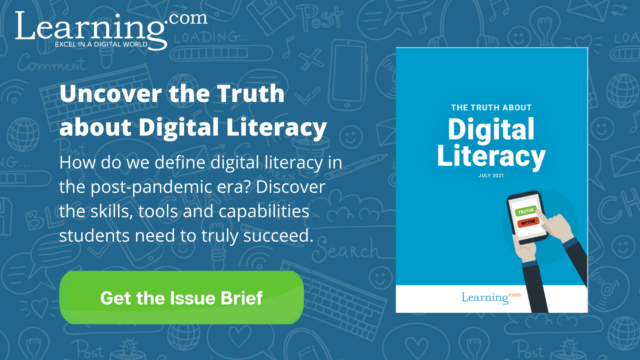You’ve probably heard “digital citizenship” being used in conjunction with digital literacy skills, but sometimes the definition can seem a little fuzzy. In this article, we discuss what digital citizenship means, the primary components of digital citizenship education, and offer resources regarding the importance of digital citizenship in students as well as ideas for promoting digital citizenship with students.
What is Digital Citizenship?
Digital citizenship is the ability to use technology responsibly, safely and respectfully. It refers to the ability to protect private information online, mitigate risks associated with cyberthreats or online threats and utilizing information and media in a respectful, knowledgeable and legal way.
Digital citizenship continues to evolve as technology becomes more complex, but the underlying theme of digital citizenship remains the same: staying safe and responsible when using digital technology.
The Components of Digital Citizenship
While the exact components of digital citizenship evolve with advances in technology, threats, media, and interconnectivity, the primary goal of digital citizenship stays relatively consistent. Some of the primary components of digital citizenship include:
Online Safety
One of the most important components of digital citizenship is the ability to stay safe online. In many digital literacy curricula, this subject has become enough of a focus that it is often contained in a separate module focusing solely on online safety. Online safety refers to the ability to protect private information and stay safe in an online environment. This includes understanding how to protect sensitive details such as name, birthday, social security numbers or home addresses, as well as identifying permissions of certain applications, enabling security protocols such as eliminating geotagging on publicly-available photos, knowing what information is safe to share and in what manner, and beyond. It also extends to identifying and mitigating cyber threats such as malware, phishing scams, ransomware, account hacking and more.
Verifying Sources
Misinformation continues to be a hot topic regarding digital media. Disinformation, deepfakes (referring to AI-manipulated images, video, and audio), intentionally deceptive propaganda, and misleading viral content is on a steep rise. This makes it more important than ever to educate our students on how to distinguish real information from fake or altered content, as well as being able to identify trustworthy resources or inspect the validity of a certain claim.
Managing Inappropriate Content
It’s also important for digital citizenship curriculum to teach how to avoid unsafe or inappropriate content online. This is especially important for young students who may stumble across unsafe or inappropriate content unintentionally or without understanding the potential dangers of such content.
Using Content Responsibly
Finally, digital citizenship should also include the ability to use content responsibly and legally. This covers a wide breadth of landscape, but includes knowing how and when to post content, how to utilize content in a respectful manner, and how to navigate the use of content while abiding by copyright laws. This refers to everything from text-based content to audio, video, imagery, graphs, presentations, spreadsheets and more.
Final Thoughts: Teaching Students Digital Citizenship
Teaching our students how to be responsible citizens has become an important part of digital literacy curriculum for students of all ages. This is because students are exposed to technology much more frequently than previous generations, with adolescents spending on average 7.5 hours daily in front of a screen. Because of this, it’s increasingly important that students understand how to protect their privacy and safety online while being able to identify and mitigate misinformation and risk as well as utilizing media respectfully and legally.
Additional Reading
For more information on digital citizenship, we invite you to download our eBook, “The Truth About Digital Literacy.”
You may also be interested in our other Digital Citizenship articles:.

Learning.com Team
Staff Writers
Founded in 1999, Learning.com provides educators with solutions to prepare their students with critical digital skills. Our web-based curriculum for grades K-12 engages students as they learn keyboarding, online safety, applied productivity tools, computational thinking, coding and more.
Further Reading
Understanding Proclamation 2024 and the TA-TEKS
Understanding Proclamation 2024 and the TA-TEKS In 2024, Texas introduced Proclamation 2024 to begin the process of adopting new instructional...
Guide to Teaching Algorithms in Computer Programming for K-12 Students
Algorithms are the heart of computer programming, providing the step-by-step instructions that computers follow to perform tasks and solve problems....
Planning Digital Literacy Assessment: A Simplified Approach
As educators know, assessments are critical to the learning process. They provide beneficial self-checks to students, informative results to...





